History of Russia
| History of Russia |
|---|
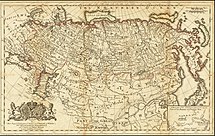 |
|
|


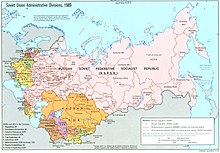
The history of Russia begins with the histories of the
Peasant revolts intensified during the nineteenth century, culminating with
By the mid-1980s, with the weaknesses of Soviet economic and political structures becoming acute,
Prehistory
The first human settlement on the territory of Russia dates back to the Oldowan period in the early Lower Paleolithic. About 2 million years ago, representatives of Homo erectus migrated from Western Asia to the North Caucasus (archaeological site of Kermek on the Taman Peninsula[6]). At Bogatyri/Sinyaya balka, in a skull of Elasmotherium caucasicum, which lived 1.5–1.2 million years ago, a stone tool was found.[7] 1.5-million-year-old Oldowan flint tools have been discovered in the Dagestan Akusha region of the north Caucasus, demonstrating the presence of early humans in the territory of present-day Russia.[8]
Fossils of
The first trace of Homo sapiens on the large expanse of Russian territory dates back to 45,000 years, in central Siberia (
During the prehistoric eras the vast
Antiquity
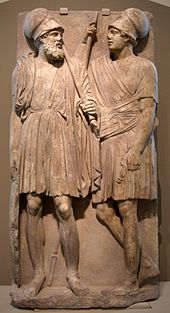
In the later part of the 8th century BCE, Greek merchants brought
Greeks, mostly from the city-state of
In the second millennium BC, the territories between the Kama and the Irtysh Rivers were the home of a Proto-Uralic-speaking population that had contacts with Proto-Indo-European speakers from the south. The woodland population is the ancestor of the modern Ugrian inhabitants of Trans-Uralia. Other researchers say that the Khanty people originated in the south Ural steppe and moved northwards into their current location about 500 AD.
A Turkic people, the
Early history
Early Slavs
Some of the ancestors of the modern
From the 7th century onwards, East Slavs constituted the bulk of the population in Western Russia
Kievan Rus' (862–1240)

Thus, the first East Slavic state,
By the end of the 10th century, the minority
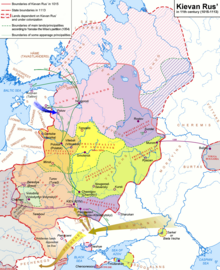
Kievan Rus' is important for its introduction of a
By the 11th century, particularly during the reign of Yaroslav the Wise, Kievan Rus' displayed an economy and achievements in architecture and literature superior to those that then existed in the western part of the continent.[43] Compared with the languages of European Christendom, the Russian language was little influenced by the Greek and Latin of early Christian writings.[34] This was because Church Slavonic was used directly in liturgy instead.[44] A nomadic Turkic people, the Kipchaks (also known as the Cumans), replaced the earlier Pechenegs as the dominant force in the south steppe regions neighbouring to Rus' at the end of the 11th century and founded a nomadic state in the steppes along the Black Sea (Desht-e-Kipchak). Repelling their regular attacks, especially in Kiev, was a heavy burden for the southern areas of Rus'. The nomadic incursions caused a massive influx of Slavs to the safer, heavily forested regions of the north, particularly to the area known as Zalesye.[citation needed]
Kievan Rus' ultimately disintegrated as a state because of in-fighting between members of the princely family that ruled it collectively. Kiev's dominance waned, to the benefit of
Mongol invasion and vassalage (1223–1480)

The invading Mongols accelerated the fragmentation of the Rus'. In 1223, the disunited southern princes faced a Mongol raiding party at the Kalka River and were soundly defeated.[46] In 1237–1238 the Mongols burnt down the city of Vladimir (4 February 1238)[47] and other major cities of northeast Russia, routed the Russians at the Sit' River,[48] and then moved west into Poland and Hungary. By then they had conquered most of the Russian principalities.[49] Only the Novgorod Republic escaped occupation and continued to flourish in the orbit of the Hanseatic League.[50]
The impact of the Mongol invasion on the territories of Kievan Rus' was uneven. The advanced city culture was almost completely destroyed. As older centers such as Kiev and Vladimir never recovered from the devastation of the initial attack,
The Mongols dominated the lower reaches of the Volga and held Russia in sway from their western capital at Sarai,[56] one of the largest cities of the medieval world. The princes had to pay tribute to the Mongols of the Golden Horde, commonly called Tatars;[56] but in return they received charters authorizing them to act as deputies to the khans. In general, the princes were allowed considerable freedom to rule as they wished,[56] while the Russian Orthodox Church even experienced a spiritual revival.
The Mongols left their impact on the Russians in such areas as military tactics and transportation. Under Mongol occupation, Muscovy also developed its postal road network, census, fiscal system, and military organization.[34]
At the same time, Prince of Novgorod, Alexander Nevsky, managed to repel the offensive of the Northern Crusades against Novgorod from the West. Despite this, becoming the Grand Prince, Alexander declared himself a vassal to the Golden Horde, not having the strength to resist its power.[neutrality is disputed]
Grand Duchy of Moscow (1283–1547)
Rise of Moscow
A major factor in the ascendancy of Moscow was the cooperation of its rulers with the Mongol overlords, who granted them the title of Grand Prince of Moscow and made them agents for collecting the Tatar tribute from the Russian principalities. The principality's prestige was further enhanced when it became the center of the Russian Orthodox Church. Its head, the Metropolitan, fled from Kiev to Vladimir in 1299 and a few years later established the permanent headquarters of the Church in Moscow under the original title of Kiev Metropolitan.
By the middle of the 14th century, the power of the Mongols was declining, and the Grand Princes felt able to openly oppose the
Ivan III, the Great

In the 15th century, the grand princes of Moscow continued to consolidate Russian land to increase their population and wealth. The most successful practitioner of this process was
Through the defections of some princes, border skirmishes, and a long war with the Novgorod Republic, Ivan III was able to annex Novgorod and Tver.
Under Ivan III, the first central government bodies were created in Russia: Prikaz. The Sudebnik was adopted, the first set of laws since the 11th century. The double-headed eagle was adopted as the coat of arms of Russia.
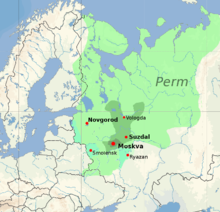
Ivan proclaimed his absolute sovereignty over all Russian princes and nobles. Refusing further tribute to the Tatars, Ivan initiated a series of attacks that opened the way for the complete defeat of the declining
In this way, internal consolidation accompanied outward expansion of the state. By the 16th century, the rulers of Moscow considered the entire Russian territory their collective property. Various semi-independent princes still claimed specific territories,
Ivan III tripled the territory of his state, ended the dominance of the
Tsardom of Russia (1547–1721)
Ivan IV, the Terrible
The development of the Tsar's autocratic powers reached a peak during the reign of
His long
In the later part of his reign, Ivan divided his realm in two. In the zone known as the
At the end of Ivan IV's reign the Polish–Lithuanian and Swedish armies carried out a powerful intervention in Russia, devastating its northern and northwest regions.[74]
Time of Troubles
The death of Ivan's childless son Feodor was followed by a period of civil wars and foreign intervention known as the Time of Troubles (1606–13).[51] Extremely cold summers (1601–1603) wrecked crops,[75] which led to the Russian famine of 1601–1603 and increased the social disorganization. Boris Godunov's reign ended in chaos, civil war combined with foreign intrusion, devastation of many cities and depopulation of the rural regions. The country rocked by internal chaos also attracted several waves of interventions by the Polish–Lithuanian Commonwealth.[76] During the
The crisis provoked a patriotic national uprising against the invasion, both in 1611 and 1612. A volunteer army, led by the merchant Kuzma Minin and prince Dmitry Pozharsky, expelled the foreign forces from the capital on 4 November [O.S. 22 October] 1612.[82][83][84]
The Russian statehood survived the "Time of Troubles" and the rule of weak or corrupt Tsars because of the strength of the government's central bureaucracy. Government functionaries continued to serve, regardless of the ruler's legitimacy or the faction controlling the throne.
Accession of the Romanovs and early rule
In February 1613, after the chaos and expulsion of the Poles from Moscow, a
The immediate task of the new monarch was to restore peace. Fortunately for Moscow, its major enemies, the Polish–Lithuanian Commonwealth and Sweden, were engaged in a bitter conflict with each other, which provided Russia the opportunity to make peace with Sweden in 1617 and to sign a truce with the Polish–Lithuanian Commonwealth in 1619.
Recovery of lost territories began in the mid-17th century, when the
The
Rather than risk their estates in more civil war, the boyars cooperated with the first Romanovs, enabling them to finish the work of bureaucratic centralization. Thus, the state required service from both the old and the new nobility, primarily in the military. In return, the tsars allowed the boyars to complete the process of enserfing the peasants.
In the preceding century, the state had gradually curtailed peasants' rights to move from one landlord to another. With the state now fully sanctioning
Riots among peasants and citizens of Moscow at this time were endemic and included the
Russian Empire (1721–1917)
Population
Much of Russia's expansion occurred in the 17th century, culminating in the first Russian colonisation of the Pacific in the mid-17th century, the Russo-Polish War (1654–1667) that incorporated left-bank Ukraine, and the Russian conquest of Siberia. Poland was divided in the 1790–1815 era, with much of the land and population going to Russia. Most of the 19th century growth came from adding territory in Asia, south of Siberia.[88]
| Year | Population of Russia (millions)[89] | Notes |
| 1720 | 15.5 | includes new Baltic & Polish territories |
| 1795 | 37.6 | includes part of Poland |
| 1812 | 42.8 | includes Finland |
| 1816 | 73.0 | includes Congress Poland, Bessarabia |
| 1914 | 170.0 | includes new Asian territories |
Peter the Great

Peter the Great (Peter I, 1672–1725) brought centralized autocracy into Russia and played a major role in bringing his country into the European state system.[90] Russia was now the largest country in the world, stretching from the Baltic Sea to the Pacific Ocean. The vast majority of the land was unoccupied, and travel was slow. Much of its expansion had taken place in the 17th century, culminating in the first Russian settlement of the Pacific in the mid-17th century, the reconquest of Kiev, and the pacification of the Siberian tribes.[91] However, a population of only 14 million was stretched across this vast landscape. With a short growing season, grain yields trailed behind those in the West and potato farming was not yet widespread. As a result, the great majority of the population workforce was occupied with agriculture. Russia remained isolated from the sea trade and its internal trade, communication and manufacturing were seasonally dependent.[92]
Peter reformed the Russian army and created the Russian navy. Peter's first military efforts were directed against the Ottoman Turks. His aim was to establish a Russian foothold on the Black Sea by taking the town of Azov.[93] His attention then turned to the north. Peter still lacked a secure northern seaport except at Archangel on the White Sea, whose harbor was frozen nine months a year. Access to the Baltic was blocked by Sweden, whose territory enclosed it on three sides. Peter's ambitions for a "window to the sea" led him in 1699 to make a secret alliance with the Polish–Lithuanian Commonwealth and Denmark against Sweden resulting in the Great Northern War.
The war ended in 1721 when an exhausted Sweden sued for peace with Russia. Peter acquired four provinces situated south and east of the Gulf of Finland, thus securing his coveted access to the sea. There, in 1703, he had already founded the city that was to become Russia's new capital, Saint Petersburg. Russian intervention in the Commonwealth marked, with the Silent Sejm, the beginning of a 200-year domination of that region by the Russian Empire. In celebration of his conquests, Peter assumed the title of emperor, and the Russian Tsardom officially became the Russian Empire in 1721.
Peter re-organized his government based on the latest Western models, molding Russia into an
Administrative

By then, the once powerful Persian
Peter the Great died in 1725, leaving an unsettled succession, but Russia had become a great power by the end of his reign. Peter I was succeeded by his second wife,
Catherine the Great

Nearly 40 years passed before a comparably ambitious ruler appeared.
Catherine spent heavily to promote an expansive foreign policy. She extended Russian political control over the Polish–Lithuanian Commonwealth with actions, including the support of the Targowica Confederation. The cost of her campaigns, plus the oppressive social system that required serfs to spend almost all their time laboring on the land of their lords, provoked a major peasant uprising in 1773. Inspired by a Cossack named Yemelyan Pugachev, with the emphatic cry of "Hang all the landlords!", the rebels threatened to take Moscow until Catherine crushed the rebellion. Like the other enlightened despots of Europe, Catherine made certain of her own power and formed an alliance with the nobility.[100]
Catherine successfully waged two wars (
In accordance to Russia's
In 1798–1799, Russian troops participated in the
Ruling the Empire (1725–1825)

Russian emperors of the 18th century professed the ideas of Enlightened absolutism. However, Westernization and modernization affected only the upper classes of Russian society, while the bulk of the population, consisting of peasants, remained in a state of serfdom. Powerful Russians resented their privileged positions and alien ideas. The backlash was especially severe after the Napoleonic wars. It produced a powerful anti-western campaign that "led to a wholesale purge of Western specialists and their Russian followers in universities, schools, and government service".[104] The mid-18th century was marked by the emergence of higher education in Russia. The first two major universities
Russia was in a continuous state of financial crisis. While revenue rose from 9 million rubles in 1724 to 40 million in 1794, expenses grew more rapidly, reaching 49 million in 1794. The budget was allocated 46% to the military, 20% to government economic activities, 12% to administration, and 9% for the Imperial Court in St. Petersburg. The deficit required borrowing, primarily from Amsterdam; 5% of the budget was allocated to debt payments. Paper money was issued to pay for expensive wars, thus causing inflation. 18th-century Russia remained "a poor, backward, overwhelmingly agricultural, and illiterate country".[105]
Alexander I and victory over Napoleon
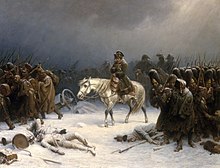
By the time of her death in 1796, Catherine's expansionist policy had made Russia a major European power. Alexander I continued this policy, wresting Finland from the weakened kingdom of Sweden in 1809 and Bessarabia from the Ottomans in 1812. His key advisor was a Polish nobleman Adam Jerzy Czartoryski.[106]
After Russian armies liberated allied Georgia from Persian occupation in 1802, they clashed with Persia over control and consolidation over Georgia, as well as the Iranian territories that comprise modern-day Azerbaijan and Dagestan. They also became involved in the Caucasian War against the Caucasian Imamate and Circassia. In 1813, the war with Persia concluded with a Russian victory, forcing Qajar Iran to cede swaths of its territories in the Caucasus to Russia,[107] which drastically increased its territory in the region. To the south-west, Russia tried to expand at the expense of the Ottoman Empire, using Georgia at its base for the Caucasus and Anatolian front.
In European policy, Alexander I switched Russia back and forth four times in 1804–1812 from neutral peacemaker to anti-Napoleon to an ally of Napoleon, winding up in 1812 as Napoleon's enemy. In 1805, he joined Britain in the
The alliance collapsed by 1810. Russia's economy had been hurt by Napoleon's Continental System, which cut off trade with Britain. As Esdaile notes, "Implicit in the idea of a Russian Poland was, of course, a war against Napoleon".[108] Schroeder says Poland was the root cause of the conflict but Russia's refusal to support the Continental System was also a factor.[109]

The
After the defeat of Napoleon, Alexander presided over the redrawing of the map of Europe at the Congress of Vienna (1814–1815), which made him the king of Congress Poland. He formed the Holy Alliance with Austria and Prussia, to suppress revolutionary movements in Europe that he saw as immoral threats to legitimate Christian monarchs. He helped Austria's Klemens von Metternich in suppressing all national and liberal movements.[114]
Although the Russian Empire would play a leading role on behalf of conservatism as late as 1848, its retention of serfdom precluded economic progress of any significant degree. As West European economic growth accelerated during the Industrial Revolution, sea trade and colonialism which had begun in the second half of the 18th century, Russia began to lag ever farther behind, undermining its ability to field strong armies.
Nicholas I and the Decembrist Revolt
Russia's great power status obscured the inefficiency of its government, the isolation of its people, and its economic backwardness.[115] Following the defeat of Napoleon, Alexander I was willing to discuss constitutional reforms, and though a few were introduced, no thoroughgoing changes were attempted.[116]
The tsar was succeeded by his younger brother,
In 1826–1828, Russia fought another war
In 1831, Nicholas crushed the November Uprising in Poland. The Russian autocracy gave Polish artisans and gentry reason to rebel in 1863 by assailing the national core values of language, religion, and culture.[120] The resulting January Uprising was a massive Polish revolt, which also was crushed. France, Britain and Austria tried to intervene in the crisis but were unable. The Russian patriotic press used the Polish uprising to unify the Russian nation, claiming it was Russia's God-given mission to save Poland and the world.[121] Poland was punished by losing its distinctive political and judicial rights, with Russianization imposed on its schools and courts.[122]
Russian Army
Tsar Nicholas I (reigned 1825–1855) lavished attention on his army.[123] In a nation of 60–70 million people, it included a million men. They had outdated equipment and tactics, but the tsar took pride in its smartness on parade. The cavalry horses, for example, were only trained in parade formations, and did poorly in battle. He put generals in charge of most of his civilian agencies regardless of their qualifications. The Army became the vehicle of upward social mobility for noble youths from non-Russian areas, such as Poland, the Baltic, Finland and Georgia.[124] On the other hand, many miscreants, petty criminals and undesirables were punished by local officials by enlisting them for life in the Army. Village oligarchies controlled employment, conscription for the army, and local patronage; they blocked reforms and sent the most unpromising peasant youth to the army. The conscription system was unpopular with people, as was the practice of forcing peasants to house the soldiers for six months of the year.[125]
Finally the Crimean War at the end of his reign showed the world that Russia was militarily weak, technologically backward, and administratively incompetent. Despite his ambitions toward the south and Ottoman Empire, Russia had not built its railroad network in that direction, and communications were poor. The bureaucracy was riddled with corruption and inefficiency and was unprepared for war. The Navy was weak and technologically backward; the Army, although very large, was good only for parades, suffered from colonels who pocketed their men's pay, poor morale, and was even more out of touch with the latest technology. The nation's leaders realized that reforms were urgently needed.[126]
Russian society in the first half of 19th century
The early 19th century is the time when Russian literature becomes an independent and very striking phenomenon.
Crimean War
Since the war against Napoleon, Russia had become deeply involved in the affairs of Europe, as part of the "Holy Alliance." The Holy Alliance was formed to serve as the "policeman of Europe." However, to maintain the alliance required large armies. Prussia, Austria, Britain and France (the other members of the alliance) lacked large armies and needed Russia to supply the required numbers, which fit the philosophy of Nicholas I. The Tsar sent his army into Hungary in 1849 at the request of the Austrian Empire and broke the revolt there, while preventing its spread to Russian Poland.[132] The Tsar cracked down on any signs of internal unrest.[133]
Russia expected that in exchange for supplying the troops to be the policeman of Europe, it should have a free hand in dealing with the decaying Ottoman Empire—the "sick man of Europe." In 1853, Russia invaded Ottoman-controlled areas leading to the Crimean War. Britain and France came to the rescue of the Ottomans. After a grueling war fought largely in Crimea, with very high death rates from disease, the allies won.[134][135]
Historian Orlando Figes points to the long-term damage Russia suffered:
- The demilitarization of the Black Sea was a major blow to Russia, which was no longer able to protect its vulnerable southern coastal frontier against the British or any other fleet.... The destruction of the Russian Black Sea Fleet, Sevastopol and other naval docks was a humiliation. No compulsory disarmament had ever been imposed on a great power previously.... The Allies did not really think that they were dealing with a European power in Russia. They regarded Russia as a semi-Asiatic state....In Russia itself, the Crimean defeat discredited the armed services and highlighted the need to modernize the countries defenses, not just in the strictly military sense, but also through the building of railways, industrialization, sound finances and so on....The image many Russians had built up of their country – the biggest, richest and most powerful in the world – had suddenly been shattered. Russia's backwardness had been exposed....The Crimean disaster had exposed the shortcomings of every institution in Russia – not just the corruption and incompetence of the military command, the technological backwardness of the army and navy, or the inadequate roads and lack of railways the accounted for the chronic problems of supply, but the poor condition and illiteracy of the serfs who made up the armed forces, the inability of the serf economy to sustain a state of war against industrial powers, and the failures of autocracy itself.[136]
Alexander II and the abolition of serfdom
When
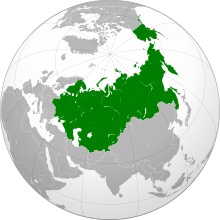
Alexander was responsible for numerous reforms besides abolishing serfdom. He reorganized the judicial system, setting up elected local judges, abolishing capital punishment, promoting local self-government through the zemstvo system, imposing universal military service, ending some of the privileges of the nobility, and promoting the universities.[141]
In foreign policy, he sold Alaska to the United States in 1867. He modernized the military command system. He sought peace, and joined with Germany and Austria in the League of the Three Emperors that stabilized the European situation. The Russian Empire expanded in Siberia and in the Caucasus and made gains at the expense of China. Faced with an uprising in Poland in 1863, he stripped that land of its separate Constitution and incorporated it directly into Russia. To counter the rise of a revolutionary and anarchistic movements, he sent thousands of dissidents into exile in Siberia and was proposing additional parliamentary reforms when he was assassinated in 1881.[142]
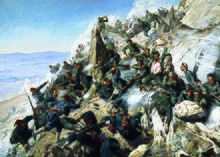
In the late 1870s Russia and the Ottoman Empire again clashed in the Balkans. The Russo-Turkish War was popular among the Russian people, who supported the independence of their fellow Orthodox Slavs, the Serbs and the Bulgarians. Russia's victory in this war allowed a number of Balkan states to gain independence: Romania, Serbia, Montenegro. In addition, Bulgaria de facto became independent. However, the war increased tension with Austria-Hungary, which also had ambitions in the region. The Tsar was disappointed by the results of the Congress of Berlin in 1878, but abided by the agreement.[143]
During this period Russia expanded its empire into Central Asia, conquering the khanates of Kokand, Bukhara, and Khiva, as well as the Trans-Caspian region.[144] Russia's advance in Asia led to British fears that the Russians planned aggression against British India. Before 1815 London worried Napoleon would combine with Russia to do that in one mighty campaign. After 1815 London feared Russia alone would do it step by step. However historians report that the Russians never had any intention to move against India.[145]
Russian society in the second half of 19th century
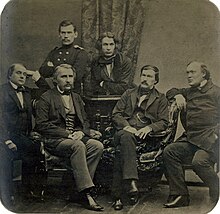
In the 1860s, a movement known as Nihilism developed in Russia. A term originally coined by Ivan Turgenev in his 1862 novel Fathers and Sons, Nihilists favoured the destruction of human institutions and laws, based on the assumption that they are artificial and corrupt. At its core, Russian nihilism was characterized by the belief that the world lacks comprehensible meaning, objective truth, or value. For some time, many Russian liberals had been dissatisfied by what they regarded as the empty discussions of the intelligentsia. The Nihilists questioned all old values and shocked the Russian establishment.[146] They became involved in the cause of reform and became major political forces. Their path was facilitated by the previous actions of the Decembrists, who revolted in 1825, and the financial and political hardship caused by the Crimean War, which caused many Russians to lose faith in political institutions.[147] Russian nihilists created the manifesto Catechism of a Revolutionary.
After the Nihilists failed to convert the aristocracy and landed gentry to the cause of reform, they turned to the peasants.
The end of the 19th century and the beginning of the 20th is known as the
Autocracy and reaction under Alexander III
Unlike his father, the new tsar
The tsar's most influential adviser was Konstantin Pobedonostsev, tutor to Alexander III and his son Nicholas, and procurator of the Holy Synod from 1880 to 1895. He taught his royal pupils to fear freedom of speech and press and to hate democracy, constitutions, and the parliamentary system.[152] Under Pobedonostsev, revolutionaries were hunted down[153] and a policy of Russification was carried out.[154]
Nicholas II and new revolutionary movement
Alexander was succeeded by his son
In 1903, the RSDLP split into two wings: the radical
At the beginning of the 20th century, Russia continued its expansion in the Far East; Chinese Manchuria was in the zone of Russian interests. Russia took an active part in the intervention of the great powers in China to suppress the Boxer rebellion. During this war, Russia occupied Manchuria, which caused a clash of interests with Japan. In 1904, the Russo-Japanese War began, which ended extremely unfavourably for Russia.
Revolution of 1905

The disastrous performance of the Russian armed forces in the Russo-Japanese War was a major blow to the Russian State and increased the potential for unrest.[157]
In January 1905, an incident known as "
In October 1905, Nicholas reluctantly issued the October Manifesto, which conceded the creation of a national Duma (legislature) to be called without delay.[157] The right to vote was extended, and no law was to go into force without confirmation by the Duma. The moderate groups were satisfied;[157] but the socialists rejected the concessions as insufficient and tried to organize new strikes. By the end of 1905, there was disunity among the reformers, and the tsar's position was strengthened.[159]
World War I
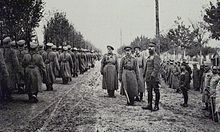
On 28 June 1914, Bosnian Serbs
The very large but poorly led and under-equipped Russian army fought tenaciously. Casualties were enormous. In the 1914 campaign, Russian forces defeated Austro-Hungarian forces in the Battle of Galicia. The success of the Russian army forced the German army to withdraw troops from the western front to the Russian front. However, defeats in Poland by the Central Powers in the 1915 campaign, led to a major retreat of the Russian army. In 1916, the Russians again dealt a powerful blow to the Austrians during the Brusilov offensive.
By 1915, morale was worsening.[163] Many recruits were sent to the front unarmed. Nevertheless, the Russian army fought on, and tied down large numbers of Germans and Austrians. When the homefront showed an occasional surge of patriotism, the tsar and his entourage failed to exploit it for military benefit. The Russian army neglected to rally the ethnic and religious minorities that were hostile to Austria, such as Poles. The tsar refused to cooperate with the national legislature, the Duma, and listened less to experts than to his wife, who was in thrall to her chief advisor, the holy man Grigori Rasputin.[164] More than two million refugees fled.[165] Repeated military failures and bureaucratic ineptitude soon turned large segments of the population against the government.[157] The German and Ottoman fleets prevented Russia from importing urgently needed supplies through the Baltic and Black seas.[157] By mid-1915 the impact of the war was demoralizing. Food and fuel were in short supply, casualties kept occurring, and inflation was mounting. Strikes increased among factory workers, and the peasants, who wanted land reforms, were restless.[166] Meanwhile, elite distrust of the regime was deepened by reports that Rasputin was gaining influence; his assassination in late 1916 ended the scandal but did not restore the autocracy's prestige.[157]
Russian Civil War (1917–1922)
Russian Revolution
In late February (3 March 1917), a strike occurred in a factory in the capital
To fill the vacuum of authority, the Duma declared a Provisional Government, headed by Prince Lvov, which was collectively known as the Russian Republic.[169] Meanwhile, the socialists in Petrograd organized elections among workers and soldiers to form a soviet (council) of workers' and soldiers' deputies, as an organ of popular power that could pressure the "bourgeois" Provisional Government.[169]
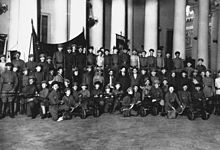
In July, following a series of crises that undermined their authority with the public, the head of the Provisional Government resigned and was succeeded by Alexander Kerensky, who was more progressive than his predecessor but not radical enough for the Bolsheviks or many Russians discontented with the deepening economic crisis and the war. The socialist-led soviet in Petrograd joined with soviets that formed throughout the country to create a national movement.[170]
The German government provided over 40 million gold marks to subsidize Bolshevik publications and activities subversive of the tsarist government, especially focusing on disgruntled soldiers and workers.[171] In April 1917 Germany provided a special sealed train to carry Vladimir Lenin back to Russia from his exile in Switzerland. After many behind-the-scenes maneuvers, the soviets seized control of the government in November 1917 and drove Kerensky and his moderate provisional government into exile, in the events that would become known as the October Revolution.[172]
When the
Russian Civil War

The Bolshevik grip on power was by no means secure, and a lengthy struggle broke out between the new regime and its opponents, which included the Socialist Revolutionaries, the anti-Bolshevik
Both sides regularly committed brutal atrocities against civilians. During the civil war era for example, Petlyura and
Estimates for the total number of people killed during the Red Terror carried out by the Bolsheviks vary widely. One source asserts that the total number of victims could be 1.3 million,[176] whereas others give estimates ranging from 10,000 in the initial period of repression[177] to 140,000[178][179] and an estimate of 28,000 executions per year from December 1917 to February 1922.[180] The most reliable estimations for the total number of killings put the number at about 100,000,[181] whereas others suggest a figure of 200,000.[182]
The Russian economy was devastated by the war, with factories and bridges destroyed, cattle and raw materials pillaged, mines flooded and machines damaged. The droughts of 1920 and 1921, as well as the
Soviet Union (1922–1991)
Creation of the Soviet Union

The
The constitution, adopted in 1924, established a federal system of government based on a pyramid of soviets in each constituent republic which culminated in the All-Union Congress of Soviets. However, while it appeared that the congress exercised sovereign power, this body was actually governed by the Communist Party, which in turn was controlled by the
War Communism and the New Economic Policy
The period from the consolidation of the Bolshevik Revolution in 1917 until 1921 is known as the period of war communism.[186] Land, all industry, and small businesses were nationalized, and the money economy was restricted. Strong opposition soon developed.[186] The peasants wanted cash payments for their products and resented having to surrender their surplus grain to the government as a part of its civil war policies. Confronted with peasant opposition, Lenin began a strategic retreat from war communism known as the New Economic Policy (NEP).[186] The peasants were freed from wholesale levies of grain and allowed to sell their surplus produce in the open market. Commerce was stimulated by permitting private retail trading. The state continued to be responsible for banking, transportation, heavy industry, and public utilities.
Although the left opposition among the Communists criticized the rich peasants, or kulaks, who benefited from the NEP, the program proved highly beneficial and the economy revived.[186] The NEP would later come under increasing opposition from within the party following Lenin's death in early 1924.[186]
Changes to Russian society

As the Russian Empire included during this period not only the region of Russia, but also today's territories of Ukraine, Belarus, Poland, Lithuania, Estonia, Latvia, Moldavia and the Caucasian and Central Asian countries, it is possible to examine the firm formation process in all those regions. One of the main determinants of firm creation for given regions of Russian Empire might be urban demand of goods and supply of industrial and organizational skill.[187]
While the Russian economy was being transformed, the social life of the people underwent equally drastic changes. The Family Code of 1918 granted women equal status to men, and permitted a couple to take either the husband or wife's name.[188] Divorce no longer required court procedure,[189] and to make women completely free of the responsibilities of childbearing, abortion was made legal as early as 1920.[190] As a side effect, the emancipation of women increased the labor market. Girls were encouraged to secure an education and pursue a career. Communal nurseries were set up for child care, and efforts were made to shift the center of people's social life from the home to educational and recreational groups, the soviet clubs.
The Soviet government pursued a policy of eliminating illiteracy (
Industrialization and collectivization
The years from 1929 to 1939 comprised a tumultuous decade in Soviet history—a period of massive industrialization and internal struggles as
In 1929, Stalin proposed the
As a part of the plan, the government took control of agriculture through the state and collective farms (
Stalinist repression
The
Stalin destroyed the opposition in the party consisting of the old Bolsheviks during the Moscow trials. The NKVD under the leadership of Stalin's commissar Nikolai Yezhov carried out a series of massive repressive operations against the kulaks and various national minorities in the USSR. During the Great Purges of 1937–38, about 700,000 people were executed.
Penalties were introduced, and many citizens were prosecuted for fictitious crimes of sabotage and espionage. The labor provided by convicts working in the labor camps of the Gulag system became an important component of the industrialization effort, especially in Siberia.[195][196] An estimated 18 million people passed through the Gulag system, and perhaps another 15 million had experience of some other form of forced labor.[197][198]
After the partition of Poland in 1939, the NKVD executed 20,000 captured Polish officers in the Katyn massacre. In the late 30s - first half of the 40s, the Stalinist government carried out massive deportations of various nationalities. A number of ethnic groups were deported from their settlement to Central Asia.
Soviet Union on the international stage
The Soviet Union viewed the 1933 accession of fervently
In 1938, Germany
World War II
On 17 September 1939, the

The peace with Germany was tense, as both sides were preparing for the military conflict,
As agreed at the

Although the Soviet Union was victorious in World War II, the war resulted in around 26–27 million Soviet deaths (estimates vary)
Cold War
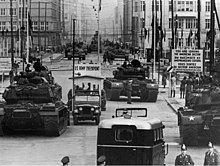
Collaboration among the major Allies had won the war and was supposed to serve as the basis for postwar reconstruction and security. USSR became one of the founders of the
The Cold War emerged from a conflict between Stalin and U.S. President
The foremost objectives of Soviet foreign policy were the maintenance and enhancement of national security and the maintenance of
As the Soviet Union continued to maintain tight control over its sphere of influence in Eastern Europe, the Cold War gave way to
U.S.–Soviet relations deteriorated following the beginning of the nine-year
De-Stalinization and the era of stagnation
Nikita Khrushchev solidified his position in a speech before the Twentieth Congress of the Communist Party in 1956 detailing Stalin's atrocities.[247]
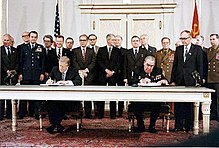
In 1964, Khrushchev was
While all modernized economies were rapidly moving to computerization after 1965, the USSR fell behind. Moscow's decision to copy the IBM 360 of 1965 proved a decisive mistake for it locked scientists into an antiquated system they were unable to improve. They had enormous difficulties in manufacturing the necessary chips reliably and in quantity, in programming workable and efficient programs, in coordinating entirely separate operations, and in providing support to computer users.[252][253]
One of the greatest strengths of Soviet economy was its vast supplies of oil and gas; world oil prices quadrupled in 1973–1974, and rose again in 1979–1981, making the energy sector the chief driver of the Soviet economy, and was used to cover multiple weaknesses. At one point, Soviet Premier Alexei Kosygin told the head of oil and gas production, "things are bad with bread. Give me 3 million tons [of oil] over the plan."[254] Former prime minister Yegor Gaidar, an economist looking back three decades, in 2007 wrote:
The hard currency from oil exports stopped the growing food supply crisis, increased the import of equipment and consumer goods, ensured a financial base for the arms race and the achievement of nuclear parity with the United States, and permitted the realization of such risky foreign-policy actions as the war in Afghanistan.[255]
Soviet space program
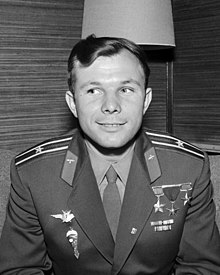
The
Perestroika and breakup of the Union
Two developments dominated the decade that followed: the increasingly apparent crumbling of the Soviet Union's economic and political structures, and the patchwork attempts at reforms to reverse that process. After the rapid succession of
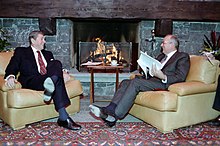
The tension between Soviet Union and Russian SFSR authorities came to be personified in the power struggle between Gorbachev and
Russian Federation (1991–present)
Liberal reforms of the 1990s
Although Yeltsin came to power on a wave of optimism, he never recovered his popularity after endorsing Yegor Gaidar's "shock therapy" of ending Soviet-era price controls, drastic cuts in state spending, and an open foreign trade regime in early 1992 (see Russian economic reform in the 1990s). The reforms immediately devastated the living standards of much of the population. In the 1990s Russia suffered an economic downturn that was, in some ways, more severe than the United States or Germany had undergone six decades earlier in the Great Depression.[263] Hyperinflation hit the ruble, due to monetary overhang from the days of the planned economy.

Meanwhile, the profusion of small parties and their aversion to coherent alliances left the legislature chaotic. During 1993, Yeltsin's rift with the parliamentary leadership led to the
Economic reforms also consolidated a semi-criminal oligarchy with roots in the old Soviet system. Advised by Western governments, the
By the mid-1990s Russia had a system of multiparty electoral politics.[265] But it was harder to establish a representative government because of the struggle between president and parliament and the anarchic party system.
Meanwhile, the central government had lost control of the localities, bureaucracy, and economic fiefdoms, and tax revenues had collapsed. Still in a deep depression, Russia's economy was hit further by the financial crash of 1998. At the end of 1999, Yeltsin made a surprise announcement of his resignation, leaving the government in the hands of the Prime Minister Vladimir Putin.[266]
Era of Putin

In 2000, the new acting president won the presidential election on 26 March and won in a landslide four years later.[267] The Second Chechen war ended with the victory of Russia. After the 11 September terrorist attacks, there was a rapprochement between Russia and the United States. Putin created a system of guided democracy in Russia by subjugating parliament, suppressing independent media and placing major oil and gas companies under state control.
International observers were alarmed by moves in late 2004 to further tighten the presidency's control over parliament, civil society, and regional officeholders.
Russia's long-term problems include a shrinking workforce, rampant corruption, and underinvestment in infrastructure.
Due to high oil prices, from 2000 to 2008, Russia's GDP at PPP doubled.

In 2014, following a controversial
On 4 December 2011, elections to the State Duma were held, as a result of which United Russia won for the third time in a row. The official voting results caused significant protests in the country; a number of political scientists and journalists noted various falsifications on election day.[277] In 2012, according to another pre-election agreement, a "castling" took place;[278] Vladimir Putin again became president and Dmitry Medvedev took over as chairman of the government, after which the protests acquired an anti-Putin orientation, but soon began to decline.[279]
Since 2015, Russia has been conducting
In 2018, Vladimir Putin was re-elected for a fourth presidential term.[281]
In 2022, Russia launched the
On 23 June 2023, the Wagner Group, a Russian paramilitary organization led by Yevgeny Prigozhin, rebelled against the government.[287] As of August 2023, the total number of Russian and Ukrainian soldiers killed or wounded during the Russian invasion of Ukraine was nearly 500,000.[288]
Historiography
See also
- Dissolution of the Soviet Union
- Family tree of the Russian monarchs
- General Secretary of the Communist Party of the Soviet Union
- History of Central Asia
- History of Siberia
- History of the administrative division of Russia
- History of the Caucasus
- History of the Jews in Russia
- History of the Soviet Union
- List of heads of government of Russia
- List of Mongol and Tatar raids against Rus'
- List of presidents of Russia
- List of Russian explorers
- List of Russian rulers
- List of wars involving Russia
- Military history of the Russian Empire
- Military history of the Soviet Union
- Politics of Russia
- Russian Armed Forces
- Russian colonization of the Americas
- Russian Empire
- Soviet Union
- Timeline of Moscow
- Timeline of Russian history
- Timeline of Russian innovation
References
- ^ "History of Russia – Slavs in Russia: from 1500 BC". Historyworld.net. Archived from the original on 9 March 2006. Retrieved 14 July 2016.
- ISBN 9781349265329.
- ISBN 9781612309019.
- ISBN 978-9527124017.
- ^ Article 1 of the Lisbon Protocol from the U.S. State Department website. Archived 28 May 2019 at the Wayback Machine
- ^ Щелинский В. Е. и др. Раннеплейстоценовая стоянка Кермек в Западном Предкавказье (предварительные результаты комплексных исследований) Archived 21 March 2021 at the Wayback Machine // Краткие сообщения ИА РАН. Вып. 239, 2015.
- ^ Щелинский В. Е. "Об охоте на крупных млекопитающих и использовании водных пищевых ресурсов в раннем палеолите (по материалам раннеашельских стоянок Южного Приазовья)" (PDF). www.archaeolog.ru (in Russian). Archived (PDF) from the original on 7 June 2023. Retrieved 17 December 2019. // Краткие сообщения Института археологии. Вып. 254. 2019
- ^ Chepalyga, A.L.; Amirkhanov, Kh.A.; Trubikhin, V.M.; Sadchikova, T.A.; Pirogov, A.N.; Taimazov, A.I. (2011). "Geoarchaeology of the earliest paleolithic sites (Oldowan) in the North Caucasus and the East Europe". Archived from the original on 20 May 2013. Retrieved 18 December 2013.
Early Paleolithic cultural layers with tools of oldowan type was discovered in East Caucasus (Dagestan, Russia) by Kh. Amirkhanov (2006) [...]
- ^ A fourth Denisovan individual Archived 15 August 2022 at the Wayback Machine, 2017.
- ^ Matthew Warren, «Mum's a Neanderthal, Dad's a Denisovan: First discovery of an ancient-human hybrid - Genetic analysis uncovers a direct descendant of two different groups of early humans», Nature, vol. 560, 23 August 2018, pp. 417-418.
- S2CID 3101375.
- ^ Mitchell, Alanna (30 January 2012). "Gains in DNA Are Speeding Research into Human Origins". The New York Times. Archived from the original on 12 September 2017. Retrieved 27 February 2017.
- ^ K. Kris Hirst Archaeology Expert. "Pre-Aurignacian Levels Discovered at the Kostenki Site". Archaeology.about.com. Archived from the original on 21 March 2021. Retrieved 18 May 2016.
- ^ a b Belinskij, Andrej; H. Härke (March–April 1999). "The 'Princess' of Ipatovo". Archeology. 52 (2). Archived from the original on 10 June 2008. Retrieved 26 December 2007.
- ISBN 0-415-32624-9.
- ^ Dr. Ludmila Koryakova, "Sintashta-Arkaim Culture" Archived 28 February 2019 at the Wayback Machine - The Center for the Study of the Eurasian Nomads (CSEN). Retrieved 20 July 2007.
- ^ 1998 NOVA documentary: "Ice Mummies: Siberian Ice Maiden" Archived 13 May 2011 at the Wayback Machine Transcript.
- ISBN 90-04-09856-9.
- ISBN 0-691-11669-5.
- ^ ISBN 0-631-20814-3.
- ISBN 0-89356-077-4.
- ISBN 90-04-09249-8.
- ISBN 963-9116-48-3.
- ^ ISBN 0-415-08064-9.
- ISBN 0-8014-3977-9.
- ^ a b David Christian, op cit., pp. 6–7.
- ^ Henry K Paszkiewicz, The Making of the Russian Nation, Darton, Longman & Todd, 1963, p. 262.
- ISBN 0-521-36447-7.
- Aleksandr Lʹvovich Mongaĭt, Archeology in the U.S.S.R., Foreign Languages Publishing House, 1959, p. 335.
- ^ a b Magocsi 2010, p. 55, 59–60.
- ISBN 0-88141-008-X.
- ^ Martin 2009b, p. 3.
- ^ Cross & Sherbowitz-Wetzor 1953, p. 38–39.
- ^ ISBN 0-16-061212-8.
- ^ James Westfall Thompson, and Edgar Nathaniel Johnson, An Introduction to Medieval Europe, 300–1500, W. W. Norton & Co., 1937, p. 268.
- ^ David Christian, Op cit. p. 343.
- ^ Particularly among the aristocracy. See World History[usurped]. Retrieved 22 July 2007.
- ISBN 0-88141-008-X.
- ISBN 0-521-86403-8.
- ^ See The Christianisation of Russia Archived 27 July 2007 at the Wayback Machine, an account of Vladimir's baptism, followed by the baptism of the entire population of Kiev, as described in The Russian Primary Chronicle.
- ISBN 0-521-45669-X.
- ^ P. N. Fedosejev, The Comparative Historical Method in Soviet Mediaeval Studies, USSR Academy of Sciences, 1979. p. 90.
- ISBN 0-7656-0976-2.
- ^ Timothy Ware: The Orthodox Church (Penguin, 1963; 1997 revision) p. 74
- ^ ISBN 0-691-02585-1
- ISBN 1-84176-233-4.
- ^ Tatyana Shvetsova, The Vladimir Suzdal Principality Archived 20 March 2008 at the Wayback Machine. Retrieved 21 July 2007.
- ^ Martin 2004, p. 139.
- ^ "The Destruction of Kiev". Archived from the original on 27 April 2011.
- ^ Jennifer Mills, The Hanseatic League in the Eastern Baltic Archived 29 June 2011 at the Wayback Machine, SCAND 344, May 1998. Retrieved 21 July 2007.
- ^ ISBN 0-16-061212-8.
- ISBN 92-3-102814-6.
- ^ a b The Battle of Kulikovo (8 September 1380) Archived 7 June 2007 at the Wayback Machine. Retrieved 22 July 2007.
- ^ Halperin 1987, p. 73–75.
- ^ Halperin 1987, p. 77–78.
- ^ a b c "History of the Mongols". History World. Archived from the original on 28 October 2018. Retrieved 26 July 2007.
- The Columbia Encyclopedia, Sixth Edition. 2001–05.
- ^ a b Ivan III Archived 15 December 2007 at the Wayback Machine, Encyclopædia Britannica. 2007
- ISBN 0-521-81227-5.
- ^ See e.g. Eastern Orthodoxy Archived 18 October 2007 at the Wayback Machine, Encyclopædia Britannica. 2007. Encyclopædia Britannica.
- ^ "The Tatar Khanate of Crimea". Archived from the original on 8 November 2017. Retrieved 12 July 2009.
- ^ J. L. I. Fennell, Ivan the Great of Moscow (1961) p. 354
- ISBN 0-691-03147-9.
- ISBN 0-313-32355-0. Archivedfrom the original on 30 October 2022.
- ^ "Ivan the Terrible". Minnesota State University Mankato. Archived from the original on 18 July 2007. Retrieved 23 July 2007.
- JSTOR 125748.
- ^ Skrynnikov R., "Ivan Grosny", p. 58, M., AST, 2001
- ^ Urban, William (Fall 1983). "The Origin of the Livonian War, 1558". Lithuanian Quarterly Journal of Arts and Sciences. Archived from the original on 30 May 2002. Retrieved 16 July 2023.
- ^ Martin 2004, p. 395.
- Siberian Chronicles, Строгановская Сибирская Летопись. изд. Спаским, СПб, 1821
- ^ Skrynnikov R. "Ivan Grozny", M, 2001, pp. 142–173
- ^ Robert I. Frost The Northern Wars: 1558–1721 (Longman, 2000) pp. 26–27
- ^ "Moscow – Historical background". The Economist: City Guide. Archived from the original on 11 October 2007.
- ^ Skrynnikov. "Ivan Grozny", M, 2001, pp. 222–223
- ISBN 5-244-00212-0, p. 190
- ^ Solovyov. "History of Russia...", v.7, pp. 533–535, 543–568
- ^ Lev Gumilev (1992), Ot Rusi k Rossii. Ocherki e'tnicheskoj istorii [From Rus' to Russia], Moscow: Ekopros.
- ^ Michel Heller (1997), Histoire de la Russie et de son empire [A history of Russia and its empire], Paris: Plon.
- ^ George Vernadsky, "A History of Russia", Volume 5, Yale University Press, (1969). Russian translation Archived 24 September 2015 at the Wayback Machine
- ^ Mikolaj Marchocki "Historia Wojny Moskiewskiej", ch. "Slaughter in the capital", Russian translation Archived 4 July 2017 at the Wayback Machine
- ^ Sergey Solovyov. History of Russia... Vol. 8, p. 847
- ISBN 0-271-02074-1
- ^ Troubles, Time of Archived 18 December 2007 at the Wayback Machine." Encyclopædia Britannica. 2006
- ^ Pozharski, Dmitri Mikhailovich, Prince Archived 11 December 2008 at the Wayback Machine", Columbia Encyclopedia
- ^ For a discussion of the development of the class structure in Tsarist Russia see Skocpol, Theda. States and Social Revolutions: A Comparative Analysis of France, Russia, and China. Cambridge University Press, 1988.
- ^ ISBN 0-415-30751-1.
- ^ (in Russian) Moscow Uprising of 1682 Archived 1 July 2017 at the Wayback Machine in the History of Russia of Sergey Solovyov
- ^ Brian Catchpole, A Map History of Russia (1974) pp 8–31; Martin Gilbert, Atlas of Russian history (1993) pp. 33–74.
- ^ Brian Catchpole, A Map History of Russia (1974) p. 25.
- ^ James Cracraft, The Revolution of Peter the Great (2003)
- ^ Basil Dmytryshyn, "Russian expansion to the Pacific, 1580–1700: a historiographical review." Slavic Studies 25 (1980): 1–25. online Archived 25 September 2019 at the Wayback Machine.
- ^ "Milov L.V. "Russian peasant and features of the Russian historical process", the research of Russian economic history of 15th–18th centuries". Archived from the original on 18 April 2009. Retrieved 6 August 2007.
- ^ Lord Kinross, The Ottoman Centuries: The Rise and Fall of the Turkish Empire (1979) p. 353.
- ISBN 9780300082661.
- ISBN 9781136453250. Archivedfrom the original on 22 January 2023. Retrieved 25 October 2015.
- ISBN 9780199878857.
- ISBN 9780300097221.
- ^ Nancy Whitelaw, Catherine the Great and the Enlightenment in Russia (Morgan Reynolds, 2005) pp 33–34.online
- ISBN 9781842125113.
- ISBN 9781317452300. Archivedfrom the original on 22 January 2023. Retrieved 25 October 2015.
- ^ "History". Parallel 60. Archived from the original on 21 January 2010. Retrieved 23 July 2007.
- ^ According to Brockhaus and Efron Encyclopedic Dictionary: 1891 Grodno province – Catholics 384,696, total population 1,509,728 [1] Archived 30 September 2007 at the Wayback Machine; Curland province – Catholics 68,722, total population 555,003 [2] Archived 30 September 2007 at the Wayback Machine; Volyhnia Province – Catholics 193,142, total population 2,059,870 [3] Archived 3 March 2016 at the Wayback Machine
- ^ Thomas McLean, The Other East and Nineteenth-Century British Literature: Imagining Poland and the Russian Empire (Palgrave Macmillan, 2012) pp. 14-40.
- ^ Alfred J. Rieber, "Persistent factors in Russian foreign policy: an interpretive essay". In Hugh Ragsdale, ed., Imperial Russian Foreign Policy (1993), p. 328.
- ISBN 978-0195033618.
- ^ Charles Morley, "Czartoryski's attempts at a new foreign policy under Alexander I." American Slavic and East European Review 12.4 (1953): 475-485.
- ISBN 1598849484
- ^ Charles Esdaile, Napoleon's Wars: An International History, 1803–1815 (2007) p. 438
- ^ Paul W. Schroeder, The Transformation of European Politics: 1763–1848 (1994) p. 419
- ^ Esdaile, Napoleon's Wars: An International History, 1803–1815 (2007) pp. 460–480
- ISBN 9780571305872.
- ISBN 978-0340069400.
- ^ Geoffrey Best, War and Society in Revolutionary Europe, 1770–1870 (1998) p. 187
- ^ Henry A. Delfiner, "Alexander I, the holy alliance and Clemens Metternich: A reappraisal." East European Quarterly 37.2 (2003): 127+.
- ^ Riasonovsky A History of Russia (fifth ed.) pp. 302–303; Charques A Short History of Russia (Phoenix, second ed. 1962) p. 125
- ^ Riasonovsky pp. 302-307
- ISBN 9781135259792. Archivedfrom the original on 22 January 2023. Retrieved 30 October 2016.
- ^ Timothy C. Dowling Russia at War: From the Mongol Conquest to Afghanistan, Chechnya, and Beyond Archived 21 October 2022 at the Wayback Machine (2014) p. 729
- ^ Riasonovsky p. 308
- ^ Stephen R. Burant, "The January Uprising of 1863 in Poland: Sources of Disaffection and the Arenas of Revolt." European History Quarterly 15#2 (1985): 131–156.
- ^ Olga E. Maiorova, "War as Peace: The Trope of War in Russian Nationalist Discourse during the Polish Uprising of 1863." Kritika: Explorations in Russian and Eurasian History 6#3 (2005): 501–534.
- ^ Norman Davies: God's Playground: A History of Poland (OUP, 1981) vol. 2, pp. 315–333, 352-363
- ^ John Shelton Curtiss, "The Army of Nicholas I: Its Role and Character," American Historical Review, 63#4 (1958), pp. 880-889 online Archived 27 July 2021 at the Wayback Machine
- ^ Elise Kimerling Wirtschafter, From Serf to Russian Soldier (1990) excerpt Archived 29 June 2013 at the Wayback Machine
- ^ Edgar Melton, "Enlightened seigniorialism and its dilemmas in serf Russia, 1750-1830." Journal of Modern History 62.4 (1990): 676–708.
- ^ E. Willis Brooks, "Reform in the Russian Army, 1856–1861." Slavic Review 43.1 (1984): 63-82 online Archived 28 July 2021 at the Wayback Machine.
- ISBN 978-0415231091.
- ^ Janko Lavrin, "Chaadayev and the West." Russian Review 22.3 (1963): 274–288 online Archived 25 March 2020 at the Wayback Machine.
- ^ Raymond T. McNally, "The Significance of Chaadayev's Weltanschauung." Russian Review 23.4 (1964): 352–361. online Archived 31 May 2022 at the Wayback Machine
- ^ Neil Cornwell, "Belinsky and V.F. Odoyevsky." Slavonic and East European Review 62.1 (1984): 6–24. online Archived 31 May 2022 at the Wayback Machine
- S2CID 145712584.
- ^ W.B. Lincoln, "Russia and the European Revolutions of 1848" History Today (Jan 1973), Vol. 23 Issue 1, pp. 53-59 online.
- ISBN 9781438108292.
- ^ Rene Albrecht-Carrie, A Diplomatic History of Europe Since the Congress of Vienna (1973) pp. 84–94
- ISBN 9781429997249.
- ^ Orlando Figes, The Crimean War, (2010) pp. 442–443.
- ^ Excerpt from "Enserfed population in Russia" Archived 22 July 2017 at the Wayback Machine published at Демоскоп Weekly, No 293 – 294, 18 June 1 July 2007
- ISBN 9780030773600.
- ^ David Moon, The Abolition of Serfdom in Russia: 1762-1907 (Routledge, 2014).
- ^ Evgeny Finkel, Scott Gehlbach, and Tricia D. Olsen. "Does reform prevent rebellion? Evidence from Russia's emancipation of the serfs." Comparative Political Studies 48.8 (2015): 984-1019. online Archived 1 August 2020 at the Wayback Machine
- ^ W. Bruce Lincoln, The Great Reforms: Autocracy, Bureaucracy, and the Politics of Change in Imperial Russia (1990).
- ^ Mosse, W. E. (1958). Alexander II and the Modernization of Russia.
- ^ Riasonovsky pp. 386–387
- ^ Riasonovsky p. 349
- ^ David Fromkin, "The Great Game in Asia" Foreign Affairs 58#4 (1980), pp. 936-951 online Archived 18 July 2021 at the Wayback Machine
- ^ Riasonovsky pp. 381–382, 447–448
- ^ I. K. Shakhnovskiĭ (1921). A Short History of Russian Literature. K. Paul, Trench, Trubner. p. 147.
- ISBN 9789401032285. Archivedfrom the original on 22 January 2023. Retrieved 19 September 2019.
- ^ ISBN 0-16-061212-8.
- ^ Waldron, Peter (2006). "Alexander II". Europe 1789–1914: Encyclopedia of the Age of Industry and Empire. 1: 40. Archived from the original on 12 January 2022. Retrieved 23 July 2019 – via GALE World History in Context.
- ^ "Orthodoxy, Autocracy, and Nationality". Encyclopædia Britannica. 26 January 2016. Archived from the original on 26 April 2008. Retrieved 23 June 2022.
- ^ Hugo S. Cunninggam, Konstantin Petrovich Pobedonostsev (1827–1907): Reactionary Views on Democracy, General Education Archived 12 June 2007 at the Wayback Machine. Retrieved 21 July 2007.
- ^ Robert F. Byrnes, "Pobedonostsev: His Life and Thought" in Political Science Quarterly, Vol. 85, No. 3 (September 1970), pp. 528–530.
- ^ Arthur E. Adams, "Pobedonostsev's Religious Politics" in Church History, Vol. 22, No. 4 (December 1953), pp. 314–326.
- ^ Hugh Seton-Watson, The Russian Empire 1801–1917 (Oxford History of Modern Europe) (1967), pp. 598–627
- ^ For an analysis of the reaction of the elites to the revolutionaries see Roberta Manning, The Crisis of the Old Order in Russia: Gentry and Government. (1982).
- ^ ISBN 0-16-061212-8.
- ^ Orlando Figes, Revolutionary Russia, 1891–1991: A History (2014) pp. 1–33
- ^ Figes, Revolutionary Russia, 1891–1991: A History (2014) pp. 33–43
- S2CID 157837365.
- ISBN 978-0-06-219922-5. p. 509.
- ^ W. Bruce Lincoln, Passage Through Armageddon: The Russians in War and Revolution, 1914–1918 (1986)
- ^ Allan K. Wildman, The End of the Russian Imperial Army (Princeton University Press, 1980) pp 76–125.
- ^ Nicholas Riasanovsky, A History of Russia (4th ed. 1984) pp. 418-20
- ^ "Refugees (Russian Empire) | International Encyclopedia of the First World War (WW1)". Archived from the original on 19 April 2017. Retrieved 18 April 2017.
- ISBN 9780195345872. Archivedfrom the original on 22 January 2023. Retrieved 25 October 2015.
- ISBN 9780521841559. Archivedfrom the original on 22 January 2023. Retrieved 25 October 2015.
- ^ Riasanovsky, A History of Russia (4th ed. 1984) pp. 455–56
- ^ History ChannelEncyclopedia.
- ^ Riasanovsky, A History of Russia (4th ed. 1984) pp. 456–460
- ISBN 9780307788573.
- ^ Riasanovsky, A History of Russia (4th ed. 1984) pp. 460–461
- ^ a b W. Bruce Lincoln, Red Victory: A History of the Russian Civil War, 1918–1921 (1999)
- ^ See Orlando Figes: A People's Tragedy (Pimlico, 1996) passim
- ^ Florinsky, Michael T. (1961). Encyclopedia of Russia and the Soviet Union. McGraw-Hill. p. 258. Archived from the original on 22 January 2023. Retrieved 22 July 2009.
- ISBN 978-3593507057.
- ISBN 978-1-138-81568-1. Archivedfrom the original on 11 November 2020. Retrieved 10 September 2019.
- ^ The Anatomy of Revolution Revisited: A Comparative Analysis of England, France, and Russia. Bailey Stone. Cambridge University Press, 25 November 2013. p. 335
- ^ "The Russian Revolution", Richard Pipes, Knopf Doubleday Publishing Group, 13 July 2011, p. 838
- ^ Ryan (2012), p. 2.
- ISBN 0671631667.
...the best estimates set the probable number of executions at about a hundred thousand.
- ISBN 9780333963074.
- ^ And Now My Soul Is Hardened: Abandoned Children in Soviet Russia, 1918–1930, Thomas J. Hegarty, Canadian Slavonic Papers
- ^ "Tsar Killed, USSR Formed Archived 19 October 2012 at the Wayback Machine," in 20th Century Russia. Retrieved 21 July 2007.
- ^ Soviet Union Information Bureau, Area and Population Archived 3 September 2017 at the Wayback Machine. Retrieved 21 July 2007.
- ^ a b c d e f g Richman, Sheldon L. (1981). "War Communism to NEP: The Road to Serfdom" (PDF). The Journal of Libertarian Studies. 5 (1): 89–97. Archived (PDF) from the original on 14 September 2014. Retrieved 3 October 2014.
- ^ Baten, Jörg; Behle, Dominic (2010). "Regional Determinants of Firm Creation in the Russian Empire. Evidence from the 1870 Industrial Exhibition". Russian Economic History Yearbook. 01 – via Researchgate.
- ^ McElvanney, Katie. "Women and the Russian Revolution". British Library. Archived from the original on 1 August 2020. Retrieved 11 May 2020.
- ^ Pushkareva, Natalia. "Marriage in Twentieth Century Russia: Traditional Precepts and Innovative Experiments" (.doc). Russian Academy of Sciences. Archived from the original on 26 July 2007. Retrieved 23 July 2007.
- PMID 1948176.
- ^ I. Deutscher, Stalin: A Political Biography, Oxford University Press, 1949, pp. 294–344.
- ^ ISBN 0-19-505180-7.
- ISBN 0-19-513104-5.
- ISBN 0-19-507132-8.
- ISBN 0-8179-3942-3.
- ISBN 0-7656-0427-2.
- ^ "Anne Applebaum – Inside the Gulag". Archived from the original on 15 October 2008.
- ISBN 0-7139-9322-7.
- ^ See, e.g. Mein Kampf
- ISBN 0-300-10068-X.
- ISBN 0-300-08981-3.
- ISBN 0-8371-9479-2.
- ISBN 0-8047-1835-0.
- JSTOR 00385859.
- ISBN 0-275-96337-3.
- ISBN 0-691-09603-1.
- ISBN 0-87052-013-X.
- ISBN 978-951-37-5278-1.
- ISBN 978-90-04-24908-0.
- ISBN 0-333-80149-0
- ISBN 0-7146-4314-9.
- ISBN 0-88033-003-1.
- ^ Tarulis, Albert N. Soviet Policy Toward the Baltic States 1918–1940. Notre Dame, IN: University of Notre Dame Press, 1959.
- ISBN 1-85065-157-4.
- ISBN 5-699-07634-4
- ISBN 5-7838-1196-3(second edition)
- ISBN 0-8050-1788-7.
- ISBN 0-252-02600-4.
- ISBN 0-688-04268-6.
- ISBN 0-670-87095-1.
- ISBN 0-7006-0717-X.
- ISBN 0-14-101747-3.
- ISBN 0-7146-5279-2.
- ISBN 0-521-78503-0), for more information.
- ISBN 0-7923-0798-4.
- ^ "Final Compensation Pending for Former Nazi Forced Laborers | DW | 27.10.2005". DW.COM. Archived from the original on 22 January 2012. Retrieved 18 April 2020.
- ^ Gerlach, C. "Kalkulierte Morde" Hamburger Edition, Hamburg, 1999
- ^ Россия и СССР в войнах ХХ века", М. "Олма- Пресс", 2001 год
- ^ Цена войны (Борис ЯЧМЕНЕВ) – "Трудовая Россия" Archived 27 September 2007 at the Wayback Machine. Tr.rkrp-rpk.ru. Retrieved 16 February 2011.
- ^ a b Рыбаковский Л. Великая отечественная: людские потери России Archived 27 September 2007 at the Wayback Machine. Gumer.info. Retrieved 16 February 2011.
- ^ "Involvement of the Lettish SS Legion in War Crimes in 1941–1945 and the Attempts to Revise the Verdict of the Nuremberg Tribunal in Latvia". Permanent Mission of the Russian Federation to the United Nations. United Nations. Archived from the original on 13 January 2009.
- ^ Permanent Mission of the Russian Federation to the United Nations (Russian Federation. General Information) Archived 11 May 2009 at the Wayback Machine. United Nations. Retrieved 16 February 2011.
- ^ "July 25: Pogrom in Lvov". Chronology of the Holocaust. Yad Vashem. Archived from the original on 11 March 2005.
- ^ "It Took Nerves of Steel". Archived from the original on 6 June 2007.
- ^ "Case Study: Soviet Prisoners-of-War (POWs), 1941–42". Gendercide Watch. Archived from the original on 15 May 2019. Retrieved 22 July 2007.
- ^ "Soviet Casualties and Combat Losses in the Twentieth Century", Greenhill Books, London, 1997, G. F. Krivosheev
- ISBN 3-8012-5016-4
- ^ "The Cold War". John F. Kennedy Presidential Library and Museum. Archived from the original on 14 February 2009. Retrieved 22 July 2007.
- ISBN 0-07-557258-3.
- JSTOR 2147826.
- ISBN 0-8133-2328-2.
- ISBN 0-19-878071-0.
- ISBN 963-7326-08-1.
- ISBN 0-8014-1775-9.
- ISBN 0-631-16775-7.
- ISBN 0-582-21504-8.
- ^ a b "Nikita Sergeyevich Khrushchev". CNN. Archived from the original on 13 June 2008. Retrieved 22 July 2007.
- ^ "Leonid Ilyich Brezhnev". CNN. Archived from the original on 13 June 2008. Retrieved 22 July 2007.
- ^ a b "Leonid Brezhnev, 1906–1982". The History Guide. Archived from the original on 13 September 2018. Retrieved 22 July 2007.
During the 1970s Brezhnev attempted to normalize relations between West Germany and the Warsaw Pact and to ease tensions with the United States through the policy known as détente. At the same time, he saw to it that the Soviet Union's military-industrial complex was greatly expanded and modernized.", "After his death, he was criticized for a gradual slide in living standards, the spread of corruption and cronyism within the Soviet bureaucracy, and the generally stagnant and dispiriting character of Soviet life in the late 1970s and early '80s.
- ^ "Soviet and Post-Soviet Economic Structure And Performance". HArper Collins. Archived from the original on 10 December 2012.
- ^ Ermolaev, Sergei. "The Formation and Evolution of the Soviet Union's Oil and Gas Dependence". Carnegie Endowment for International Peace. Archived from the original on 4 October 2022. Retrieved 4 October 2022.
- ^ James W. Cortada, "Public Policies and the Development of National Computer Industries in Britain, France, and the Soviet Union, 1940—80." Journal of Contemporary History (2009) 44#3 pp. 493–512, especially pp. 509-510.
- S2CID 154809517.
- ^ Yergin, The Quest (2011) p. 23
- ISBN 978-0815731153. Archivedfrom the original on 20 October 2023. Retrieved 25 October 2015.
- ^ Steve Garber (19 January 2007). "Sputnik and The Dawn of the Space Age". NASA. Archived from the original on 20 May 2020. Retrieved 22 July 2007.
History changed on October 4, 1957, when the Soviet Union successfully launched Sputnik I. The world's first artificial satellite...
- ^ Neil Perry (12 April 2001). "Yuri Gagarin". The Guardian. UK. Archived from the original on 12 January 2022. Retrieved 22 July 2007.
12 April 2001 is the fortieth anniversary of Yuri Gagarin's flight into space, the first time a human left the planet
- ^ David Pryce-Jones (20 March 2000). "Boris on a Pedestal". National Review. Archived from the original on 2 June 2007. Retrieved 22 July 2007.
In the process he engaged in a power struggle with Mikhail Gorbachev...
- ^ "Boris Yeltsin". CNN. Archived from the original on 13 June 2008. Retrieved 22 July 2007.
The first-ever popularly elected leader of Russia, Boris Nikolayevich Yeltsin was a protégé of Mikhail Gorbachev's.
- ^ "Government". Country Studies. Archived from the original on 20 May 2018. Retrieved 22 July 2007.
Because of the Russians' dominance in the affairs of the union, the RSFSR failed to develop some of the institutions of governance and administration that were typical of public life in the other republics: a republic-level communist party, a Russian academy of sciences, and Russian branches of trade unions, for example.
- ^ a b "Timeline: Soviet Union". BBC. 3 March 2006. Archived from the original on 28 August 2017. Retrieved 22 July 2007.
1991 25 December – Gorbachev resigns as Soviet president; US recognises independence of remaining Soviet republics
- ^ "Russian Soviet Federal Socialist Republic". The Free Dictionary. Archived from the original on 12 January 2012. Retrieved 22 July 2007.
The largest republic of the former Soviet Union; it became independent as the Russian Federation in 1991
- ^ Peter Nolan, China's Rise, Russia's Fall. Macmillan Press, 1995. pp. 17–18.
- S2CID 155013709.
- ^ "Russian president praises 1990s as cradle of democracy". Johnson's Russia List. Archived from the original on 11 July 2007. Retrieved 20 July 2007.
- ^ CNN Apologetic Yeltsin resigns; Putin becomes acting president Archived 13 November 2007 at the Wayback Machine. Written by Jim Morris. Published 31 December 1999.
- ^ "Putin's hold on the Russians". BBC. 28 June 2007. Archived from the original on 17 December 2017. Retrieved 22 July 2007.
In the 2000 election, he took 53% of the vote in the first round and, four years later, was re-elected with a landslide majority of 71%.
- ^ "Putin's hold on the Russians". BBC. 28 June 2007. Archived from the original on 17 December 2017. Retrieved 22 July 2007.
But his critics believe that it has come at the cost of some post-communist democratic freedoms.", "2003: General election gives Putin allies control over parliament"
- ^ a b CIA World Fact Book – Russia
- ^ "The Russian Federation Today". Guide to Russia's HISTORY OF RUSSIA. Archived from the original on 7 May 2012. Retrieved 12 August 2013.
- ^ "Russia's GDP according to the World Bank". Archived from the original on 28 January 2021. Retrieved 26 August 2020.
- ^ "Russia: How Long Can The Fun Last?". Archived from the original on 13 December 2006. Bloomberg BusinessWeek
- ^ "Sochi 2014 Olympic Winter Games | Britannica". www.britannica.com. Archived from the original on 22 September 2022. Retrieved 4 October 2022.
- ^ "Crimea referendum: Voters 'back Russia union'". BBC News. 16 March 2014. Archived from the original on 17 June 2018. Retrieved 4 October 2022.
- from the original on 2 January 2020. Retrieved 4 October 2022.
- ^ "NATO Review - Sanctions after Crimea: Have they worked?". NATO Review. 13 July 2015. Archived from the original on 4 October 2022. Retrieved 4 October 2022.
- ^ Государственная дума должна быть переизбрана Archived 1 January 2014 at the Wayback Machine // Vedomosti, 21 September 2012.
- ^ "Путин заявил, что договорился с Медведевым о "рокировке" 4 года назад" [Putin said that he agreed with Medvedev on “castling” 4 years ago]. 17 October 2011. Archived from the original on 18 December 2019. Retrieved 18 December 2019.
- ^ Bidder, Benjamin; Offenberg, Anastasia (12 March 2012). "Protest gegen Putin: Russlands Schneerevolution schmilzt" [Protest against Putin: Russia's snow revolution is melting]. InoPressa. Archived from the original on 28 March 2017.
- ^ "Russian Lessons from the Syrian Operation and the Culture of Military Innovation". www.marshallcenter.org. Archived from the original on 10 October 2022. Retrieved 4 October 2022.
- ^ "Vladimir Putin secures record win in Russian presidential election". The Guardian. 19 March 2018. Archived from the original on 8 October 2022. Retrieved 4 October 2022.
- ^ "Russia's Putin authorises 'special military operation' against Ukraine". Reuters. 24 February 2022. Archived from the original on 24 February 2022. Retrieved 3 April 2022.
- ^ "Stocks fall, ruble dives as Russia sanctions hit world markets". Reuters. 28 February 2022. Archived from the original on 29 March 2022. Retrieved 3 April 2022.
- ^ "Russian economy may need a decade to return to pre-sanctions levels, Sberbank says" (Reuters, 17 June 2022) Archived 17 July 2022 at the Wayback Machine
- ^ Maynes, Charles (30 September 2022). "Putin illegally annexes territories in Ukraine, in spite of global opposition". NPR. Archived from the original on 5 October 2022. Retrieved 4 October 2022.
- ^ "War crimes have been committed in Ukraine conflict, top UN human rights inquiry reveals". UN News. 23 September 2022. Archived from the original on 4 December 2022. Retrieved 4 October 2022.
- ^ Yeung, Jessie (25 June 2023). "Moscow has stepped back from civil war with Wagner. But the danger's not over, experts warn". CNN. Archived from the original on 29 June 2023. Retrieved 29 June 2023.
- ^ Cooper, Helene; Gibbons-Neff, Thomas; Schmitt, Eric; Barnes, Julian E. (18 August 2023). "Troop Deaths and Injuries in Ukraine War Near 500,000, U.S. Officials Say". The New York Times. Archived from the original on 3 September 2023. Retrieved 3 September 2023.
Further reading
Surveys
- Auty, Robert, and Dimitri Obolensky, eds. Companion to Russian Studies: vol 1: An Introduction to Russian History (1981) 403 pages; surveys by scholars.
- Bartlett, Roger P. A History of Russia (2005) online
- Brown, Archie et al. eds. The Cambridge Encyclopedia of Russia and the Former Soviet Union (2nd ed. 1994) 664 pages online
- Bushkovitch, Paul. A Concise History of Russia (2011) excerpt and text search Archived 25 May 2017 at the Wayback Machine
- Connolly, Richard. The Russian Economy: A Very Short Introduction (Oxford University Press, 2020). Online review Archived 16 November 2020 at the Wayback Machine
- Figes, Orlando. Natasha's Dance: A Cultural History of Russia (2002). excerpt Archived 3 October 2016 at the Wayback Machine
- Florinsky, Michael T. ed. McGraw-Hill Encyclopedia of Russia and the Soviet Union (1961).
- Freeze, Gregory L., ed.,. Russia: A History. 2nd ed. (Oxford UP, 2002). ISBN 0-19-860511-0.
- Harcave, Sidney, ed. Readings in Russian history (1962) excerpts from scholars. online
- Hosking, Geoffrey A. Russia and the Russians: a History (2011) online
- Jelavich, Barbara. St. Petersburg and Moscow: Tsarist and Soviet Foreign Policy, 1814–1974 (1974).
- Kort, Michael. A Brief History of Russia (2008) online
- McKenzie, David & Michael W. Curran. A History of Russia, the Soviet Union, and Beyond. 6th ed. Belmont, CA: Wadsworth Publishing, 2001. ISBN 0-534-58698-8.
- Millar, James, ed. Encyclopedia of Russian History (4 vol. 2003). online
- Pares, Bernard. A History of Russia (1926) By a leading historian. Online
- Paxton, John. Encyclopedia of Russian History (1993) online
- Paxton, John. Companion to Russian history (1983) online
- Perrie, Maureen, et al. The Cambridge History of Russia. (3 vol. Cambridge University Press, 2006). excerpt and text search Archived 17 March 2016 at the Wayback Machine
- Riasanovsky, Nicholas V., and Mark D. Steinberg. A History of Russia (9th ed. 2018) 9th edition 1993 online
- Service, Robert. A History of Modern Russia: From Tsarism to the Twenty-First Century (Harvard UP, 3rd ed., 2009) excerpt Archived 29 March 2022 at the Wayback Machine
- Stone, David. A Military History of Russia: From Ivan the Terrible to the War in Chechnya excerpts Archived 25 May 2017 at the Wayback Machine
- Ziegler; Charles E. The History of Russia (Greenwood Press, 1999)
Russian Empire
- Baykov, Alexander. “The Economic Development of Russia.” Economic History Review 7#2 1954, pp. 137–149. online Archived 22 April 2022 at the Wayback Machine
- Billington, James H. The icon and the axe; an interpretive history of Russian culture (1966) online
- Christian, David. A History of Russia, Central Asia and Mongolia. Vol. 1: Inner Eurasia from Prehistory to the Mongol Empire. Malden, MA: Blackwell Publishers, 1998. ISBN 0-631-20814-3.
- De Madariaga, Isabel. Russia in the Age of Catherine the Great (2002), comprehensive topical survey
- Fuller, William C. Strategy and Power in Russia 1600–1914 (1998) excerpts Archived 25 March 2021 at the Wayback Machine
- Hughes, Lindsey. Russia in the Age of Peter the Great (Yale UP, 1998), Comprehensive topical survey. online
- Kahan, Arcadius. The Plow, the Hammer, and the Knout: An Economic History of Eighteenth-Century Russia (1985)
- Kahan, Arcadius. Russian Economic History: The Nineteenth Century (1989)
- Gatrell, Peter. "Review: Russian Economic History: The Legacy of Arcadius Kahan" Slavic Review 50#1 (1991), pp. 176–178 online Archived 22 April 2022 at the Wayback Machine
- Lincoln, W. Bruce. The Romanovs: Autocrats of All the Russias (1983) online, sweeping narrative history
- Lincoln, W. Bruce. The great reforms : autocracy, bureaucracy, and the politics of change in Imperial Russia (1990) online
- Manning, Roberta. The Crisis of the Old Order in Russia: Gentry and Government. Princeton University Press, 1982.
- Markevich, Andrei, and Ekaterina Zhuravskaya. 2018. “Economic Effects of the Abolition of Serfdom: Evidence from the Russian Empire.” American Economic Review 108.4–5: 1074–1117.
- Mironov, Boris N., and Ben Eklof. The Social History of Imperial Russia, 1700–1917 (2 vol Westview Press, 2000)
- Moss, Walter G. A History of Russia. Vol. 1: To 1917. 2d ed. Anthem Press, 2002.
- Oliva, Lawrence Jay. ed. Russia in the era of Peter the Great (1969), excerpts from primary and secondary sources online
- Pipes, Richard. Russia under the Old Regime (2nd ed. 1997)
- Seton-Watson, Hugh. The Russian Empire 1801–1917 (Oxford History of Modern Europe) (1988) excerpt and text search Archived 15 April 2017 at the Wayback Machine
- Treasure, Geoffrey. The Making of Modern Europe, 1648–1780 (3rd ed. 2003). pp. 550–600.
Soviet era
- Chamberlin, William Henry. The Russian Revolution 1917–1921 (2 vol 1935) online free
- Cohen, Stephen F. Rethinking the Soviet Experience: Politics and History since 1917. (Oxford University Press, 1985)
- Cross, Samuel Hazzard; Sherbowitz-Wetzor, Olgerd P. (1953) [1930]. The Russian Primary Chronicle, Laurentian Text. Translated and edited by Samuel Hazzard Cross and Olgerd P. Sherbowitz-Wetzor (PDF). Cambridge, Massachusetts: The Mediaeval Academy of America. Archived (PDF) from the original on 27 August 2021. Retrieved 26 January 2023.
- Davies, R. W. Soviet economic development from Lenin to Khrushchev (1998) excerpt Archived 27 December 2022 at the Wayback Machine
- Davies, R.W., Mark Harrison and S.G. Wheatcroft. The Economic transformation of the Soviet Union, 1913-1945 (1994)
- Figes, Orlando. A people's tragedy a history of the Russian Revolution (1997) online
- Fitzpatrick, Sheila. The Russian Revolution. (Oxford University Press, 1982), 208 pages. ISBN 0-19-280204-6
- Gregory, Paul R. and Robert C. Stuart, Russian and Soviet Economic Performance and Structure (7th ed. 2001)
- Hosking, Geoffrey. The First Socialist Society: A History of the Soviet Union from Within (2nd ed. Harvard UP 1992) 570 pages
- Kennan, George F. Russia and the West under Lenin and Stalin (1961) online
- Kort, Michael. The Soviet Colossus: History and Aftermath (7th ed. 2010) 502 pages
- Kotkin, Stephen. Stalin: Paradoxes of Power, 1878–1928 (2014); vol 2 (2017)
- Library of Congress. Russia: a country study edited by Glenn E. Curtis. (Federal Research Division, Library of Congress, 1996). online Archived 11 July 2012 at archive.today
- Lincoln, W. Bruce. Passage Through Armageddon: The Russians in War and Revolution, 1914–1918 (1986)
- Lewin, Moshe. Russian Peasants and Soviet Power. (Northwestern University Press, 1968)
- McCauley, Martin. The Rise and Fall of the Soviet Union (2007), 522 pages.
- Moss, Walter G. A History of Russia. Vol. 2: Since 1855. 2d ed. Anthem Press, 2005.
- ISBN 0-14-015774-3.
- Ofer, Gur. "Soviet Economic Growth: 1928-1985," Journal of Economic Literature (1987) 25#4: 1767–1833. online Archived 11 November 2020 at the Wayback Machine
- Pipes, Richard. A concise history of the Russian Revolution (1995) online
- Regelson, Lev. Tragedy of Russian Church. 1917–1953. http://www.regels.org/Russian-Church.htm Archived 17 February 2015 at the Wayback Machine
- Remington, Thomas. Building Socialism in Bolshevik Russia. Pittsburgh: University of Pittsburgh Press, 1984.
- Service, Robert. A History of Twentieth-Century Russia. 2nd ed. Cambridge, MA: Harvard University Press, 1999. ISBN 0-674-40348-7.
- Service, Robert. Stalin: A Biography (2004), along with Tucker and Kotkin, a standard biography
- Steinberg, Mark D. The Russian Revolution, 1905–1921 (Oxford Histories, 2017).
- Tucker, Robert C. Stalin as Revolutionary, 1879–1929 (1973); Stalin in Power: The Revolution from Above, 1929–1941. (1990)along with Kotkin and Service books, a standard biography; online at ACLS e-books
Post-Soviet era
- ISBN 978-0-230-61773-5
- Cohen, Stephen. Failed Crusade: America and the Tragedy of Post-Communist Russia. New York: W.W. Norton, 2000, 320 pages. ISBN 0-393-32226-2
- Gregory, Paul R. and Robert C. Stuart, Russian and Soviet Economic Performance and Structure, Addison-Wesley, Seventh Edition, 2001.
- ISBN 978-1-4426-1021-7. Archivedfrom the original on 23 April 2023. Retrieved 27 June 2023.
- Medvedev, Roy. Post-Soviet Russia A Journey Through the Yeltsin Era, Columbia University Press, 2002, 394 pages. ISBN 0-231-10607-6
- Moss, Walter G. A History of Russia. Vol. 2: Since 1855. 2d ed. Anthem Press, 2005. Chapter 22.
- Smorodinskaya, Tatiana, and Karen Evans-Romaine, eds. Encyclopedia of Contemporary Russian Culture (2014) excerpt Archived 30 March 2022 at the Wayback Machine; 800 pp covering art, literature, music, film, media, crime, politics, business, and economics.
- Stent, Angela. The Limits of Partnership: U.S.-Russian Relations in the Twenty-First Century (2014)
Atlases, geography
- Blinnikov, Mikhail S. A geography of Russia and its neighbors (Guilford Press, 2011)
- Barnes, Ian. Restless Empire: A Historical Atlas of Russia (2015), copies of historic maps
- Catchpole, Brian. A Map History of Russia (Heinemann Educational Publishers, 1974), new topical maps.
- Channon, John, and Robert Hudson. The Penguin Historical Atlas of Russia (Viking, 1995), new topical maps.
- Chew, Allen F. An Atlas of Russian History: Eleven Centuries of Changing Borders (Yale UP, 1970), new topical maps.
- Gilbert, Martin. Routledge Atlas of Russian History (4th ed. 2007) excerpt and text search online
- Henry, Laura A. Red to Green: environmental activism in post-Soviet Russia (2010)
- Kaiser, Robert J. The Geography of Nationalism in Russia and the USSR (1994).
- Medvedev, Andrei. Economic Geography of the Russian Federation by (2000)
- Parker, William Henry. An historical Geography of Russia (University of London Press, 1968)
- Shaw, Denis J. B. Russia in the Modern World: A New Geography (Blackwell, 1998) of Finland.
Historiography
- Baron, Samuel H., and Nancy W. Heer. "The Soviet Union: Historiography Since Stalin." in Georg G. Iggers and Harold Talbot Parker, eds. International handbook of historical studies: contemporary research and theory (Taylor & Francis, 1979). pp. 281–94.
- Boyd, Kelly, ed. (1999). Encyclopedia of Historians and Historical Writing vol 2. Taylor & Francis. pp. 1025–41. ISBN 9781884964336.
- Confino, Michael (2009). "The New Russian Historiography and the Old—Some Considerations". History & Memory. 21 (2): 7–33. S2CID 145645042– via Muse.
- Cox, Terry (2002). "The New History of the Russian Peasantry". Journal of Agrarian Change. 2 (4): 570–86. .
- David-Fox, Michael et al. eds. After the Fall: Essays in Russian and Soviet Historiography (Bloomington: Slavica Publishers, 2004)
- Dmytryshyn, Basil (1980). "Russian expansion to the Pacific, 1580–1700: A Historiographical Review" (PDF). Slavic Studies. 25: 1–25.
- Firestone, Thomas. "Four Sovietologists: A Primer." National Interest No. 14 (Winter 1988–9), pp. 102–107 on the ideas of Zbigniew Brzezinski, Stephen F. Cohen, Jerry F. Hough, and Richard Pipes.
- Fitzpatrick, Sheila. "Revisionism in Soviet History" History and Theory (2007) 46#4 pp. 77–91 online, covers the scholarship of the three major schools, totalitarianism, revisionism, and post-revisionism.
- Halperin, Charles J. (1987). Russia and the Golden Horde: The Mongol Impact on Medieval Russian History. Indiana University. p. 222. ISBN 9781850430575. (e-book).
- Martin, Janet (2004). Medieval Russia: 980–1584. Cambridge: Cambridge University Press. ISBN 9780521368322. Archivedfrom the original on 23 April 2023. Retrieved 11 October 2015. (digital printing 2004)
- Martin, Janet (2009b). "From Kiev to Muscovy: The Beginnings to 1450". In Freeze, Gregory (ed.). Russia: A History. Oxford: Oxford University Press. pp. 1–30. ISBN 978-0-19-150121-0. (third edition)
- Martin, Russell E (2010). "The Petrine Divide and the Periodization of Early Modern Russian History". Slavic Review. 69 (2): 410–425. S2CID 164486882.
- Orlovsky, Daniel (1990). "The New Soviet History". Journal of Modern History. 62 (4): 831–50. S2CID 144848873.
- Sanders, Thomas, ed. Historiography of Imperial Russia: The Profession and Writing of History in a Multinational State (1999).
- Suny, Ronald Grigor. "Rehabilitating Tsarism: The Imperial Russian State and Its Historians. A Review Article" Comparative Studies in Society and History 31#1 (1989) pp. 168–179 online
- Topolski, Jerzy. "Soviet Studies and Social History" in Georg G. Iggers and Harold Talbot Parker, eds. International handbook of historical studies: contemporary research and theory (Taylor & Francis, 1979. pp. 295–300.
- Winkler, Martina (2011). "Rulers and Ruled, 1700–1917". Kritika: Explorations in Russian and Eurasian History. 13 (4): 789–806. S2CID 145335289.
Primary sources
- Kaiser, Daniel H. and Gary Marker, eds. Reinterpreting Russian History: Readings 860-1860s (1994) 464 pages excerpt and text search; primary documents and excerpts from historians
- Vernadsky, George, et al. eds. Source Book for Russian History from Early Times to 1917 (3 vol 1972)
- Seventeen Moments in Soviet History (An on-line archive of primary source materials on Soviet history.)
External links
- Guides to Sources on Russian History and Historiography
- History of Russia: Primary Documents
- Дневник Истории России A historic project supported by the Ministry of Culture of the Russian Federation.

